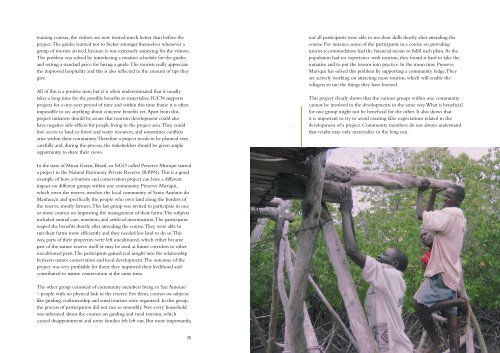OMSLAG 5.indd - IUCN
OMSLAG 5.indd - IUCN
OMSLAG 5.indd - IUCN
Create successful ePaper yourself
Turn your PDF publications into a flip-book with our unique Google optimized e-Paper software.
training courses, the visitors are now treated much better than before the<br />
project. The guides learned not to bicker amongst themselves whenever a<br />
group of tourists arrived, because it was extremely annoying for the visitors.<br />
The problem was solved by introducing a rotation schedule for the guides<br />
and setting a standard price for hiring a guide. The tourists really appreciate<br />
the improved hospitality and this is also reflected in the amount of tips they<br />
give.<br />
All of this is a positive start, but it is often underestimated that it usually<br />
takes a long time for the possible benefits to materialize. <strong>IUCN</strong> supports<br />
projects for a one-year period of time and within this time frame it is often<br />
impossible to say anything about concrete benefits yet. Apart from this,<br />
project initiators should be aware that tourism development could also<br />
have negative side-effects for people living in the project area. They could<br />
lose access to land, to forest and water resources, and sometimes conflicts<br />
arise within their community. Therefore a project needs to be planned very<br />
carefully and, during the process, the stakeholders should be given ample<br />
opportunity to share their views.<br />
In the state of Minas Gerais, Brazil, an NGO called Preserve Muriqui started<br />
a project in the Natural Patrimony Private Reserve (RPPN). This is a good<br />
example of how a tourism and conservation project can have a different<br />
impact on different groups within one community. Preserve Muriqui,<br />
which owns the reserve, involves the local community of Santo Antônio do<br />
Manhuaçu and specifically the people who own land along the borders of<br />
the reserve, mostly farmers. This last group was invited to participate in one<br />
or more courses on improving the management of their farms. The subjects<br />
included animal care, nutrition, and artificial insemination. The participants<br />
reaped the benefits shortly after attending the course. They were able to<br />
run their farms more efficiently and they needed less land to do so. This<br />
way, parts of their properties were left uncultivated, which either became<br />
part of the nature reserve itself or may be used as future corridors to other<br />
uncultivated parts. The participants gained real insight into the relationship<br />
between nature conservation and local development. The outcome of the<br />
project was very profitable for them: they improved their livelihood and<br />
contributed to nature conservation at the same time.<br />
The other group consisted of community members living in San Antonio<br />
– people with no physical link to the reserve. For them, courses on subjects<br />
like guiding, craftsmanship and rural tourism were organized. In this group,<br />
the process of participation did not run so smoothly. Not every household<br />
was informed about the courses on guiding and rural tourism, which<br />
caused disappointment and some families felt left out. But more importantly,<br />
30 31<br />
...<br />
...<br />
not all participants were able to use their skills shortly after attending the<br />
course. For instance, none of the participants in a course on providing<br />
tourist accommodation had the financial means to fulfil such plans. As the<br />
population had no experience with tourism, they found it hard to take the<br />
initiative and to put the lessons into practice. In the mean time Preserve<br />
Muriqui has solved this problem by supporting a community lodge. They<br />
are actively working on attracting more tourists, which will enable the<br />
villagers to use the things they have learned.<br />
This project clearly shows that the various groups within one community<br />
cannot be involved in the developments in the same way. What is beneficial<br />
for one group might not be beneficial for the other. It also shows that<br />
it is important to try to avoid creating false expectations related to the<br />
development of a project. Community members do not always understand<br />
that results may only materialize in the long run.
















